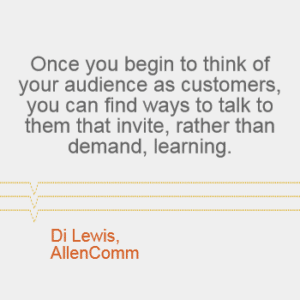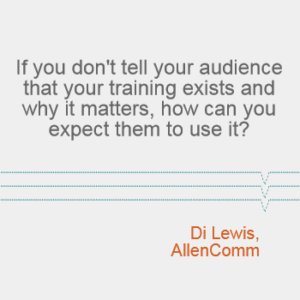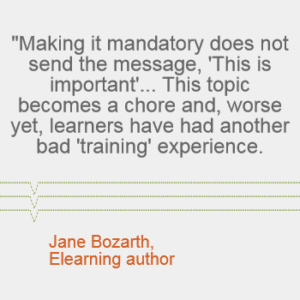Communicating in Training: Saying the right thing to the right person at the right time
Once you’ve begun to really understand the true challenges, needs and interests learners face in their day-to-day work (rather than just looking at demographics), you can begin to talk to your audience in ways that connects with and engages them as individuals. You need to know who you are talking to before you say something. Similarly, once you begin to think of your audience as customers, you can find ways to talk to them that invite, rather than demand, learning.
Knowing how, when, where and what you are communicating to your audience is key to the success of any project. We live in a world where your audience is getting bombarded with messages, and the ones that work are personalized to the individual—their interests, activities, job and other details.
Learning and development understands how to target learner behaviors when it comes to a business need. But too many departments still operate under a “If you build it, they will come” mentality. Thousands of content graveyards on many companies’ LMSes prove that’s not the case.
If you want your project, particularly your high-value project, to succeed, you must communicate.
The impact of not communicating about a training project
When businesses fail to communicate the value of their products, they go out of business. When you fail to communicate the value of your training, the project will not make an impact.
In a 2013 study by the Project Management Institute, they found “ineffective communications is the primary contributor to project failure one third of the time, and had a negative impact on project success more than half the time.” Without a strong communication plan in place, you risk project failure or serious underperformance.
In a recent study by CB Insights, the company analyzed 135 failed startups and the reasons why they failed. While most businesses had several reasons that contributed to failure, several of the most prominent will be familiar to any trainer who’s had a project fall flat:
Just as entrepreneurs fall so in love with the idea of their product that they neglect the market analysis, time the launch correctly and communicate effectively to customers, trainers can be so excited about a great project that they don’t think about how they’re going to get people involved.
Much of the reason we believe you need to see learners as customers is because your learners have options and if you want them to choose your training, you need to communicate value. Customers have a myriad of choices when it comes to buying almost any product. Learners now too have an enormous amount of information at their fingertips. If you don’t tell your audience that your training exists and why it matters, how can you expect them to use it?
And don’t think making training mandatory will make up for a lack of communication. It only compounds the problem. As Harvard sociologist Frank Dobbin points out, “If you force someone to go to something, they don’t have to try to make their beliefs and actions line up,” says Dobbin. “In fact, you can think, ‘I’m only here because they forced me to do this.'” The training becomes a box to check, and not something seen as genuinely insightful.
Elearning author and professional Jane Bozarth agrees, saying, “You won’t find many articles or discussions on the topic of communities of practice without someone asking how we can control and manage them, how we can make people participate, and when we should enroll our new hires in them. Here’s the thing: You can’t.” She continues, “Making it mandatory does not send the message, ‘This is important’, but, ‘This is so awful we have to put a gun to your head to make you attend.’ This topic becomes a chore and, worse yet, learners have had another bad ‘training’ experience.”
What should you be doing to effectively communicate value to your audience? While no single blog post can cover all the communication strategies and tactics that may be useful, these three tips will get you started and should spark a more in-depth look at how you talk about your training programs.
1. Create A Communication Calendar
Building out the messaging you need in a calendar format helps you see exactly what you need to say and when. A calendar is also great for spelling out who is responsible for each step of the plan to keep yourself and your team accountable to the plans and deadlines.
To give you a jumping off point, the U.S. Department of Health and Human Services says a communication plan will help you answer the following kinds of questions:
Your messaging should be different at different points in your program.
- WHO do you need to communicate with?
- WHY are those people/organizations important to communicate with?
- WHAT do they need to know (or do)?
- WHEN do they need to know it?
- HOW do you communicate with them efficiently and effectively?
- WHERE do you deliver or store the material (communications medium)?
Think about some of your most recent training projects. Did you have different employee groups in your audience? Were there multiple pieces to the training? How are they going to be able to access the courses? Did your program need follow up? The answers to all of these questions will change how you communicate about your training program.
A calendar will help you organize what you need to communicate and when. Your messaging should be different at different points in your program. Learners don’t need to get everything (or worse, nothing) right at the start. Keep your deadlines and messages straight with a communication calendar. Although this blog is talking about a marketing editorial calendar, it will get you started with the basics of what a calendar should include.
2. Be personal in message and channel.
74% of online consumers get frustrated with websites when the content has nothing to do with their interests
Your audience is becoming accustomed to personalized messages in their everyday lives. Almost 70% of workers say the first thing they do when they need to learn something for their jobs is Google it. Fewer than 12 percent turn to their learning organization first, according to research from Degreed. That’s because Google has spent a lot of time and money making sure when you search using Google the results are relevant to your search.
One of the key elements of a communication plan for training is to help learners understand the relevance of the program to them. If you’re providing generic messaging that doesn’t speak to learner pain points and daily job duties, it’s far more likely that they’ll tune out.
While crafting messages that speak to different segments of your audience takes time, it will also pay off enormously in how much they are invested in your training. Using the insights you gained from a more empathetic learner analysis, you will understand the messages that will most resonate as well as the communication channels each audience uses and responds to best.
According to a study by Janrain, 74% of online consumers get frustrated with websites when the content has nothing to do with their interests. Now imagine if you didn’t have to overcome that kind of roadblock when launching a new training program.
3. Be willing to mix up the formats of your messaging.
While some employees are great at seeing (and reading) every email, others aren’t. Perhaps you have a company messaging system that everyone checks like Slack or Yammer. Depending on the size of the company, an all-employee meeting can be good at getting the message out. A short video could do the trick for some employees.
Whatever the case for your organization, it’s important to think about each segment of learners and not only what medium is easiest for the message, but what each group of people will best respond to. If you have a great launch email, but it takes a lot of text to explain what’s awesome about this new program, you could lose a good chunk of your learners’ interest. It may be that even using the same message, a short email introducing a brief video could be better at engaging learners and getting audience buy-in.
Part of your planning process when creating a communication calendar should be considering what medium is best for the message and the recipient. It’s not easy to balance those two concerns with what is doable for your department, but by adding them into the mix, you’ll be one step closer to the success of your training initiative.
Communicating your training is key to the success of your L&D initiatives.
Although an L&D communication strategy requires more planning and analysis, your programs will be more successful and you’ll be better prepared to demonstrate that success. Next time we’ll look at the importance of involving influencers in your training initiative. Learn how to recruit and activate project champions in a way that will improve your success.









Comments 1
Yes! Communicating your training is key to the success of your l&d initiatives.